#synapsid evolution
Explore tagged Tumblr posts
Text

Inostrancevia latifrons - A large gorgonopsid from the Late Permian period (259-251.9 Mya), that lived in what is now Russia.
Inostrancevia was one of the largest gorgonopsids, a group of predatory therapsids known for their large saber-teeth and blunt snouts. Unfortunately Inostrancevia and the rest of the gorgonopsids would be wiped out during the worst mass extinction in Earth's history.
#inostrancevia#gorgonopsid#synapsid#therapsid#paleoart#paleontology#evolution#animal art#animals#zoology#permian
26 notes
·
View notes
Text
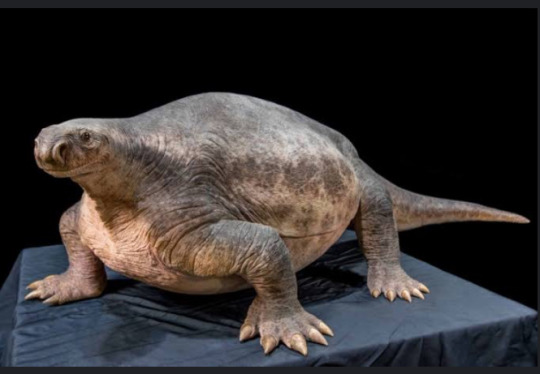
#can you believe this dude was a real animal that existed at some point#cotylorhynchus#caseidae#science#paleontology#evolution#scientists of tumblr#proto-mammals#synapsid
36 notes
·
View notes
Text
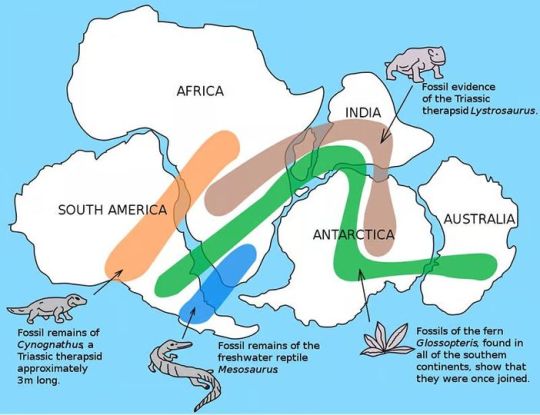
Continental drift fossil evidence.
As noted by Snider-Pellegrini and Alfred Wegener, the locations of certain fossil plants and animals on present-day, widely separated continents would form definite patterns (shown by the bands of colors), if the continents are rejoined.
via: United States Geological Survey (USGS)
#synapsid#cynognathus#lystrosaurus#mesosaurus#maps#fossils#prehistoric#earth science#science#paleontology#animals#nature#evolution#geology#continental drift#pangea
120 notes
·
View notes
Text
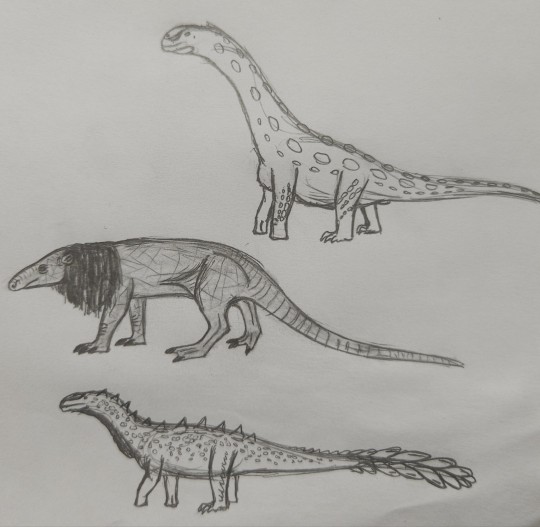

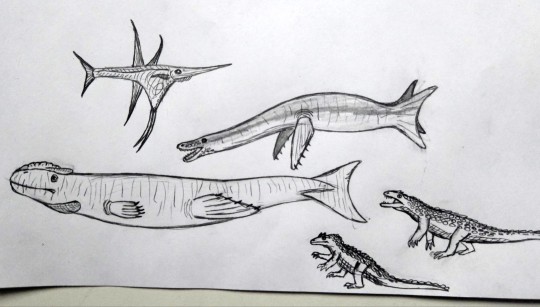
Didn't do art much lately (at least the one i can show) but here are some sketches
#creature design#spec evo#speculative biology#spec bio#speculative evolution#dinosaur#reptile#synapsid#mammal#sauropod
6 notes
·
View notes
Text
Fun fact: while I was looking for paint color ideas for this Dimetrodon in a jar, I found out Dimetrodon was not actually a dinosaur. All those children’s books about dinosaurs with pictures of Dimetrodon in them? Lies. Dinosaur toy play sets with Dimetrodon figurines? LIES. However, I’ve decided to ignore that fact because he’s my favorite. Suck it, evolution.
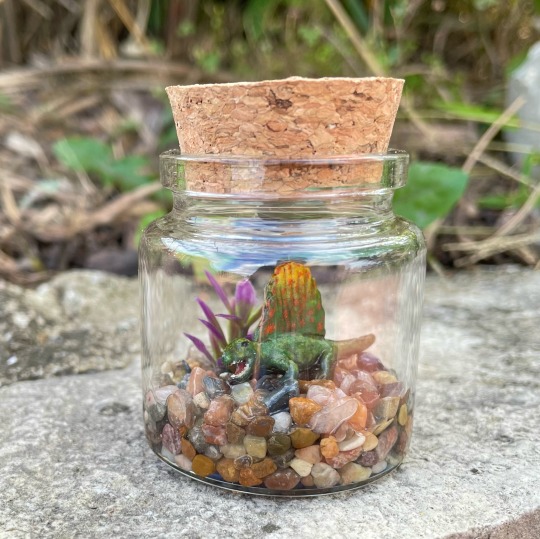
#dinosaurs#dimetrodon#Jurassic#paleontology#paleoart#terrarium#etsy sellers#miniature terrarium#dinosaur#evolution#jurassic park#jurassic world#etsy#synapsid#reptiles#a conspiracy by Big Science to oust the coolest dinosaur
37 notes
·
View notes
Text
Taxa Revisited (Chortis: Territory of Magic) (2 of 2)

Taxa listed:
Ab - The River sheep (Epicanthosaurus ovis) is a species of herbivorous hydroherperian synapsid specialized to eat algae and water plants. They are largely aquatic, only going on land to bask (they are viviparous).
Element: Water
Timid animals, they flee upon sensing predators, such as sharks, odontocetes, and large dyptosaurs.
Bb - The Muotopara (Stenellasaura caerulea) is a well-known species of marine dyptosaur found in the warm parts of Chortis's oceans. It feeds exclusively on fish, squids, and belemnites. Despite all appearances, dyptosaurs are more closely related to sauropods and saurian wyverns than they are to the extinct ichthyosaurs. This technically makes them true dinosaurs.
Element: Water
Cb - The ruby seadragon (Ferventidon rubrocetus) is a mid-sized sea dragon species endemic to the northern coasts of East Soso. It feeds on small fish and crustaceans. Despite its diet, it is highly aggressive, particularly during mating season and its bite has been known to cause severe burns and wounds. When angered, its red-coloration becomes vibrant.
Element: Dragon/Fire
Db - The sea camel (Hydrocamelix gigas), despite its name, is actually a species of toothless marine palaeanodont, making it related to pangolins. Unlike its terrestrial predecessors, it is a herbivore and one of three selenanodontian species on Chortis.
They are largely placid, only using their weight to fend against predators that will eat their young. Adults do not have predators.
Element: Earth
Eb - Domplerichthys hadeli, the giant critterfish, is a large species of mola-like pleuronectiform native to warm waters. Despite being slow, it is not defenseless as it is actually highly poisonous due to its diet of man-o-war-like siphonophores.
Element: Water/Poison
Fb- The northern sea panther (Thalassotigris umbra) might resemble a seal at first, but it is actually a species of feliform related to mongooses. Despite the name, it feeds on small vertebrates, only occasionally eating carrion and sick animals. Social and cooperative animals, they are seen huddled together in order to survive the Amaic cold.
Element: Ice
Gb- The lotus puella or rhubarb puella (Lotodraco virgo) is a species of puma-sized omnivorous frog wyvern native to the deltas and rivers of East Gurujan. It will eat almost anything using its long tongue though it prefers to eat crustaceans, lotuses and smaller amphibians. Puella eggs can stay dormant in dry earth for an unusually long amount of time, hatching when the conditions become suitable. The eggs are protected by an antibiotic gel that is unsuitable for bacterial and fungal growth. A 999 year old egg was successfully hatched long ago by villagers. The adult organisms can live for at least 60-150 years, a lot shorter and more reasonable than the egg itself.
Element: Plant/Light/Water

Oh yeah, and the tadpoles (which are herbivores)
#speculative biology#chortis: territory of magic#speculative evolution#worldbuilding#creature design#dragon#dinosaur#Mammal#Synapsid#Fish
6 notes
·
View notes
Text

My tribute to the first amniote - ancestor of all vertebrates able to reproduce on land. This small, superficially lizard-like creature used to dart around steamy carboniferous forests. It was small but it marked a huge milestone in evolution, being the first vertebrate to lay hard-shelled eggs, leading to all the synapsids, reptiles and parareptiles. If this single mutation had not occurred exactly then and there, or if too many of those animals got eaten by giant bugs and amphibians, leading to their extinction, the most iconic and significant part of land animals would not exist today. Pay respect to our great ancestor :D
5 notes
·
View notes
Text
FreddyFan95's Parasynapsid made accurate || Magnusaurus

Early depictions of this animal show it as a more spinosaur-like animal; however, a recent study makes Magnusaurus look unlike the sailed fish eaters. Belonging to a strange group of Parasynapsida. But it is still up for debate on whether or not they're true synapsids or just a case of convergent evolution. But the recent description of the Pilosatheriid Parasynapsid Nyembambarhychus in 2023 showed that the group could be stem-Synapsids.
2 notes
·
View notes
Text
Tropical Diploterro (Pseudosauropodus tropicalis) – Regal Grass Mover


“ A shaggy, grass holding queen. ”
– Rebecca Crane
Tropical Diploterro (Pseudosauropodus tropicalis) is the fictional species of cynodont introduced in Historya Davvun and Worldcraft series.
What is this grass?
The female used the grass and algae known as Diploterro's Hair Grass (Capillogramenus pseudosaurpodus), used as microhabitat for bugs and other critters on her back. The male one doesn't have, probably be ugliest.
Physiology
This synapsid resembles a sauropod, except for their feet and teeth, as a result of convergent evolution. The female one is microecology. The Tropical Diploterro has chestnut-colored skin with peach belly and limb pads, grayish nails on elephantine legs, a longer neck and tail, a low row of edges near the eyes, and ears set near the jaw. The male lacks the plant on its back; only females do.
Abilities
Diploterro had a super weight, and the limbs could cause stun, confusion, and stampede; even using their mouths caused bleeding, and the tail served as a tail. The Tropical Diploterro spits algae or plants with saliva, causing leafblight.
These fur-like structures are algae and grasses that absorbs photosynthesis, which are home to grasshoppers, moths, dragonflies, butterflies, silverfish, and springtails. The plant is called Diploterro's Hair Grass due to its relationship with algae and animals, which is involved in symbolism. This grass was considered harvestable by us, and it regrows after being harvested in just 8 days.
Behavior
The Diploterro is believed to be a land-based animal that lived in herds, similar to unrelated sauropods. Due to their extreme predisposition for violent aggression, diplodoterros will readily attack people and other carnivores.
Distribution and Habitat
The male one lived in plains, swamps, savannas, and others, and the female one was only in forests but migrated to another biome for mating.
Reference
#ognimdo2002#earth responsibly#science fantasy#earth#art#earthresponsibly#fairytale#speculative evolution#ibispaint art#tropical Diploterro#Diploterro#synapsid#cynodont#rapunzles tangled adventure#assassin's creed#monster hunter#historya davvun#worldcraft#worldcraftdamnation#ibis paint x#art ph#grass#spectember#botany#god knows hudas not pay
4 notes
·
View notes
Text
Ok I just wanna take it back to if humans tried to mate with insert pictures of animals. Those were pictures of (I'm pretty sure) one platypus and three echidnas. Platypuses and echidnas are monotremes, aka egg laying mammals. After sauropsids(group that evolved into reptiles and birds) and synapsids(group that evolved into mammals and shit) split, the synapsids continued evolving on a similar path until they were primitive mammals. Then, monotremes split off from the main crowd(eutherians) and did their own thing and now they can lay eggs and lactate. The eutherians then split off into marsupials and therians(it is an actual thing istg) and then those split off into other shit I don't care enough to research more on. So yeah, we are very very very distantly related to monotremes. You are closer related to a mouse or binturong(bearcat that smells like popcorn) than a platypus. Also now you know more about monotreme evolution.
(please take everything I say with a grain of salt I am not a professional I was curious so I researched platypus evolution if I'm wrong don't come for me)
NEW FISH JUST DROPPED
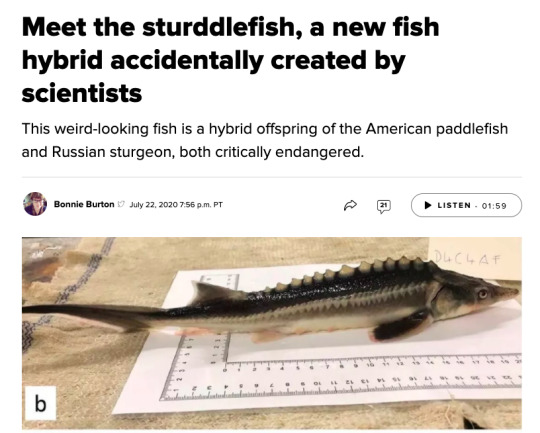
#rant post#rant#special interest#platypus#platypuses#echidna#echidnas#monotreme#monotremes#animal evolution#animals#evolution#sauropsids#synapsids#mammalian evolution
142K notes
·
View notes
Text

Lystrosaurus was a genus of synapsid that originated in the late Permian period some 250 mya, and was one of the few survivors of the most devastating mass extinction the world has ever seen. After around 95% of life on earth had gone extinct, Lystrosaurus thrived on what little vegetation had survived and made up a large portion of the global population at the time.
25 notes
·
View notes
Text
youtube
#youtube#vandalia1998#Gutsick Gibbon#jackson wheat#human evolution#synapsid#therapsid#cynodont#mammals#primates#Monkeys#apes#humans
0 notes
Text
Non human Ancestors
I was just thinking... often I see a lot about ancestor work (something that I don’t actually do for reasons lol) which is mostly aimed to human ancestors, our beloved past generations that we never were able to know; but I was taking a shower and it occurred to me: What about our ancestors that are so back in time that are not even human? They existed, right?
Specially having in mind that humans (“modern” humans) are actually so new in the big scheme of the evolution line. As someone said, from Jesus (Year 0) to now, to around 30 years between generations, there are around 56 mothers long (some put up to 80 or 100 mothers). Which is an actually ridiculously small fragment of time. Don’t get me wrong, is a lot of time to us, but the earth is quite oldy. Also, interesting fact: 1 generation ago you have 2 parents, 2 generations ago you have 4 grandparents… 56 generations ago you have 16,000,000,000,000,000 ancestors! So each time you do ancestor work, you have a little army up there lol.
Back to what matters. There were humans before the year 0. There was a moment when they were not even humans, but their evolved blood still flows on out veins, their evolutionary bias still affects us. We find calmness on the shower because we once were living on the water. Our strong emotional based reactions come from the times where our rational thinking wasn’t a thing. The appendix is considered a small leftover from one of our plant-eating ancestors. The coccyx is all that remains of our ancestral tails. Humans pay extra attention to the red color because was a sign of a ripe fruit (and blood). Hiccups might be attributed to an ancient amphibian ancestor. That we and other mammals have 5 fingers is rooted to a dang fish! Our fear of dark, the way we unconsciously analyze others, how we manage to unconsciously pick the “best partner”, the virus and bacteria that live in our bodies in a symbiotic way, and so on. Almost all what we are now, mentally, emotionally and physically, is a result of millions of years of evolution, of species that don’t look like us. An almost endless line of lucky and well adapted creatures, in a web of evolution, trial and error, until now. So why only focus on our modern human ancestors? One of you ancient grandmothers was a “fish”, she did her part and she know things that we have no idea, so why don’t ask them for aid?
From the Homo Sapiens (Us, in the last 500.000 years) with their extreme mental developed brains, their, inventive, problem solving, creativity, to the Homo Erectus being the first to cook food (controlled fire), to make handaxes, to hunt and gather in coordinated groups, in caring for injured or sick group members, to walk fully straight as us; to the Australopithecus, and back to our unknown Hominini “Missing Link”.
From the Purgatorius, the progenitor of primates, to the Pelycosaur, the one from which Sauropsids (the ancestors of reptiles of all sorts) and of Synapsids (that's mammals AND their ancestors) split off from.
From the Hylonomus, the first reptile, to the Tiktaalik, the first fish in venture to leave the ocean and walk in the earth, to the Agnatha, the first fish.
To the Urmetazoan, the hypothetical last common ancestor of all animals.
3.7 billion years old of ancestors. I think is poetic to think about it. The spirit of some Homo Erectus getting happy when you lit a candle, the Tiktaalik’s spirit noticing how you are in ease when you take a long shower, a fluffy Synapsids’s energy remembering their old times when you sleep comfy on your bed, an anxious Purgatorius’s spirit who see you eat your veggies just like they did… So many unknown ancestors, from the most primitive form of life, seeing their evolutionary mark on you.
I don’t know, maybe is time to drop a snack in their name, who knows which knowledge they can bring us back, from their experiences in a time where life wasn’t easy, from a time where the earth wasn’t even remotely similar to our earth now. We are almost aliens to them, but we carry them, deep inside our DNA. Who knows in which funky animalistic way they can aid us? Is worthy to think about it, at least for a while. They deserve the recognition too…

#witchcraft#witch#pagan#paganism#witchy#witchblr#witches#ancestor work#ancestors#advance witch#advanced witchcraft#nature#i don't consume weird stuffs i swear
57 notes
·
View notes
Text
youve definitely taken your dicynodonts in good speculative direction. quills, crests, what appears to be a solid lump of keratin above the shoulder blade, akin to those weird muscle-connected ceratopsian frills? perfect. quarter billion years will do that to a mf.
the theriodonts could stand a similar glowup. though it wouldn't be the first time a species went more or less unchanged, even as it went from tiny double digit kilogram rat to 5+ tonne megatheropod.
in particular, there's no reason for these to be a solid brown. in fact, as non-mammal therapsids, all four of these would have a similar visual range to reptiles, as modern mammals underwent a very specific genetic bottleneck, which may not have applied even to mesozoic clades.
the blue tipped tail, subtly green fur, and bright facial marking are excellent additions, and if im being honest, the overall lack of color for these four can quite clearly showcase their habitats, and they could very well possess uv markings i can't see or cant be depicted.
but as i stated, we can get more obviously derived. large robust apex nocturnal/forest predators wouldn't benefit much from bright glow-in-the-dark markings on their front, but a tail that fans out into bright uv patterns could very well be hidden from prey and revealed to intimidate competitors or occasional threats. underbelly patterns would also be useful for this. inflatable nasal cavaties, largely hidden within fur but revealed for display could also apply. horns/crests that can be flushed with blood could also occur and are even found within a few species. bony horns and branching antler-like structures are well known features of therapsids, even very carnivorous therapsids, living in rich ecosystems.
and of course, nothing really stopped any of them from developing digitigrade limbs, there just wasn't a need. pareiasaurs were slow, heavily armored game. their limbs weren't even held below the body they were spread out to the side. most species weren't much bigger than a large boar because of this, and they were a lot slower. probably not even able to properly run.
sorry if this all seems insulting. i know that random words on the internet can very easily seem like harsh, scathing insults and even irl i have issues showcasing tone. i promise im just excited to see some speculations on classic permian fauna, of which the only other example ive really seen is @tales-of-kaimere's permian islands and continent, along with a few scraps of their dynasty. it's good spec-evo, yes, but the theriodonts are kinda shoehorned into dragon-hood, and the dicynodonts are... well honestly they are kinda just a masterclass in rapid radiation. no notes there.
but they don't have back-shields akin to the neckless ceratopsids, or grand-crests with fearsome quills.
im really excited for a new perspective.
sorry for the... 300 words.
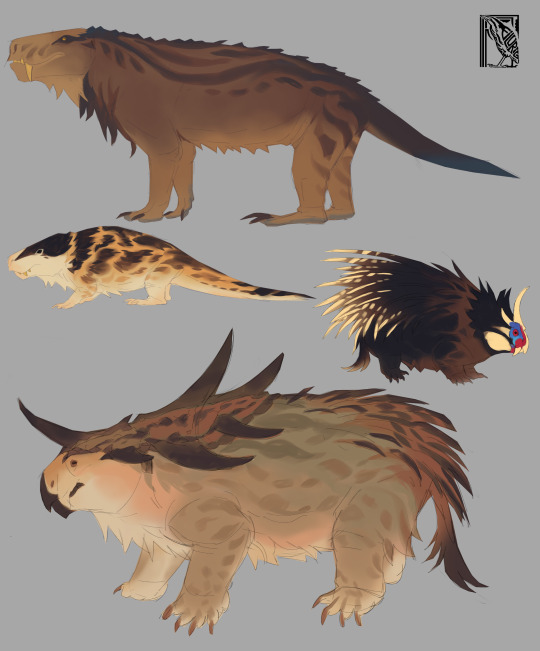
some more sillyworld doodles of probable "therapsids" present in a certain part of the world. i think in most of the continents on the Sillyworld Planet "primitive" therapsids died out except on the northwestern continent (name TBA), where they're the most predominant "mammals".
#worldbuilding#speculative biology#spec evo#speculative evolution#spec bio#therapsid#dicynodont#gorgonopsid#therocephalian#cynodont#synapsid
396 notes
·
View notes
Note
How hermaphrodite mammals elves could work? How any hermaphrodite mammals humanoid could work? How they could ever come into beging if we assume that gods guide evolution not create outright? How any isolated continent dominated by hermaphrodite mammals and birds and reptliles could work?
while I still can't find any official science community consensus on an alternative term for hermaphroditic species, I did find a new suggested word from 2024: "gonosimulism"
Gonosimulism - An alternative to ‘hermaphrodite’ in biology
Gonosimulistic - referring a sexually reproducing species in which all individuals produce both male and female gametes. Animal species in which individuals are either male or female (with intersex variation) are gonochoric, also spelled gonochoristic, which is the opposite of gonosimulistic.
Etymology
This term was derived from its antonym gonochoristic, or gonochoric, which has a meaning derived from Greek; (gone, (gono) meaning generation) + (chorizein (chori), meaning to separate) Gonosimulistic has similar etymology; derived from both Greek and Latin; (gone, (gono) meaning generation) + (simul, meaning to combine, or at the same time).
just a neat little bonus there, because I know the use of "hermaphrodite" has become a source of contention due to its history of being used as a derogatory term against intersex people. Likewise, I have also seen "agametic" as a new term to describe asexual reproduction, though I'm not sure it's commonly used yet. it's good to see changes like this.
Now, on to the actual question. Mammals that can effectively produce both eggs and sperm don't exist in reality, but in a fantasy world or an alien world, especially with explanations like a literal deity who could have created any living creatures or people they wanted, you have a lot more room for weirdness.
anatomical requirements:
if they're going to be capable of producing both eggs and sperm, and also be able to give birth, there's a lot of anatomy to deal with. This could be cut down by making them egg-laying mammals like the platypus, as they would not need a large womb to produce eggs.
you could also give them a cloaca, which is rather common outside of mammalian species, to simplify things just a bit more. They can still have a penis, as there are animals with both a cloaca and a penis. as long as they have some way to get the sperm into the uterus, they'll be fine.
ultimately, if you're going for evolutionary explanations, I would just say it's a good idea to look back at some prehistoric animals that existed before the modern mammals, such as early synapsids, as well as monotremes like the platypus. you can also look at non-mammalian animals that have unusual reproductive tactics. pretty much all the real world examples of things like gonosimulism will be fish, invertebrates, amphibians, and reptiles. it's not the same, but you could research parthenogenesis as well, which is the ability to produce cloned offspring.
if they're mammals, they'll also produce milk through mammary glands.
Worldbuilding:
in a people species that has no biological distinctions between male and female, they also probably wouldn't have any social concept of gender. their pronouns may be based on something else, like age or social status, if their language even bothers with distinct pronouns. They may have a preference for which reproductive role they take, or maybe they always do both at once with a bonded partner. there are a lot of ways to build up unique cultures around this idea.
any deities they worship would likely be depicted with the same anatomy, and if they met people who were strictly male and female, they'd probably be quite baffled.
how do they view each part of the reproductive process? how do their relationships work? what about childcare? etc.
hopefully that all helps with your worldbuilding! good luck
23 notes
·
View notes
Note
Please talk about birds and why their existence is horrifying!
For dabble prompt, Yang and Weiss making macaroni, as inspired by the recent Instagram where Barbara and Kara made macaroni.
You can request a ramble and drabble here, and see prompts I've finished and am currently working on!
Ramble - I have a lot of Emotions about birds and their relationship to mammals.
Drabble - The college AU returns: guess who has no fucking idea how to make macaroni, and who else finally got fed up with it.
Birds. Birds my beloved, birds my beloathed.
Here's the thing. Every time I research birds, for any reason, I learn something new and horrifying. I could fill a post the length of Do You Like The Color Of The Sky with the shit I know and fear about birds. Rather than go into a specific reason, let me explain the underlying reason why I find them both fascinating and disturbing.
Birds are endotherms (warmblooded), like us. They have a four-chambered heart, like us. They have complex social behaviours across multiple unrelated genera, like mammals. Many unrelated bird species use tools and can solve human puzzles. While not shared with us, birds also have paired larynx structures that let them make insanely complex noises. Between the intelligence and this ability, many species are capable of mimicking human speech - and at least one species has both scientific and anecdotal evidence of being able to use human speech to communicate. (The only mammal proven to be able to mimic verbal speech is a goddamn Grey Seal btw)
All of this is lovely until you take a step back and realize our ancestors diverged 300 million years ago. Our shared ancestral traits are a handful of internal changes, the loss of gills, keratinized skin, and fucking chest breathing. That is how goddamn little we have in common with birds ancestrally. To be clear, the first true mammal came along closer to 225 mya - but we are the only living group left from the synapsids, then therapsids, that grew Better Teeth and split off. In comparison, birds and crocodiles are the only living members from archosauria, and the arrival of birds themselves is still under a lot of debate but was probably around 150 mya.
This is the part that I find so fascinating. Go all the way back to that paragraph with all the things we share with birds. Both mammals and birds evolved all of those traits separately. And yet, despite being so far away that we may as well be alien, we've ended up on a parallel course to each other. Almost every part of our body, right down to the brain, works in a completely different way and yet the outcome is spookily similar. We can reason. We can problem-solve.
We've gotten to the point that a well-educated human and a well-educated grey parrot have stood eye to eye with each other and had a true, verbal, two-way conversation.
Seriously. Think about that. That's something we had to use sign language to do with our closest living relatives, and talking buttons to do with our longest-running domesticated companion species - and both happened in the last few decades. The first account of a 'talking parrot' was in 5th century BC.
I think that's a significant connection, on the grand cosmic scale of time and evolution. Sister groups not in blood but in destination, driven by curiosity and a miraculous set of coincidences, reach out and speak to each other in a language both are able to understand.
And I didn't even touch the fact that birds and mammals are the only two living vertebrates that developed fucking flight.
---
"I wouldn't use this in a hot pan, it's plastic."
"Oh." A pause. "Right."
Yang's voice coming from the kitchen wasn't new, but Weiss' certainly was. Blake poked out from her room, curious enough about the potential of dying in a house fire to emerge from midterm studying.
Immediately she saw Ruby, pressed up against the wall to stare down the stairs. The younger woman turned, catching sight of Blake and pressing a finger to her lips before motioning her forwards, kneeling to clear room for her. Blake slowly crept up, leaning over Ruby as they both peered around the corner.
Down the stairs, the small, messy kitchen was visible. Weiss Schnee hovered over the stove, hair pulled up in a ponytail and eyes wide with uncharacteristic worry. "Okay, I think it's all combined."
"Good, now you can pour the milk in." Yang appeared from behind the wall in their view, where she must have been standing by the fridge. "Don't do it all at once, pour in about... here. That much. Whisk it together until there's no clumps and then add the rest."
Blake turned her gaze downwards, bewildered.
"Weiss admitted she doesn't know how to cook mac and cheese." Ruby whispered. "Yang couldn't let that one go."
She had to bite her lip to keep from laughing. It was probably bound to happen. Weiss hadn't had to cook for herself a day in her life, and Yang had probably been cooking for herself and Ruby since she could reach the stove. Sooner or later, there would have to be a collision. Of course, she had to feel a bit bad that no one had ever taken the time to teach Weiss any of it. But any guilt she felt was immediately overwhelmed by the sheer surrealism of the scene unfolding in the kitchen. Weiss had merely brushed off all points at her complete lack of housekeeping and cooking. And now here she was, taking lessons from the person who gave her the most shit for it.
"This all seems complicated?" The trademark Weiss sass wasn't gone entirely, even with her being miles out of her element. "Isn't mac and cheese supposed to be a really simple thing that kids can make?"
"That's Kraft dinner. This isn't much harder to make and tastes way better, so we're starting with it. Relax, ice queen, it's hard to screw it up completely."
Weiss heaved a frustrated sigh, whether it was at the nickname or the recipe wasn't clear. "Is the pasta in yet?"
"Nope, water still isn't boiling." Yang had leaned against the cupboards, clearly amused.
"They always say, to uh." Weiss looked up, blinking. "A watched- when you look- when you watch the bowl of- it never boils." She looked over, as if hoping Yang might have understood the verbal equivalent of an orchestra falling down the stairs.
Yang nodded sagely. "Exactly."
Blake pulled herself away from the corner, barely choking back laughter. Ruby's breathing devolved into chaotic inhales.
"Seriously, what is the saying?! Something about pots? And watching it?"
"No, no you nailed it. A watched when you look when you watch-"
"Yang Xiao Long I will beat you with this spatula I swear to God."
She could hear the grin in Yang's voice. "You and what ladder?"
That was the final straw for both Blake and Ruby. Ruby broke first, the laugh escaping like a water from a high pressure hose. Within moments both of them were in hysterics, Ruby on the floor and Blake leaning against the wall, fighting for air.
"Well." Blake managed to look over, and found Weiss glaring at them both from the bottom of the stairs, hands on her hips. "If you two are going to have input, you may as well get downstairs and help cook."
It was a fair enough point, and the two women managed to pull themselves down the stairs and into the kitchen, still wiping tears away. Yang watched them sit down at the table, clearly fighting back a laugh of her own.
Weiss re-entered the kitchen, frowning down at the water in the pot. A split second of quiet.
Blake wasn't much of a comedian - but she knew when the timing was right. "A watched pot never boils, Weiss."
Yang broke like china, falling against the fridge with a howl of laughter. A spatula bounced off the center of Blake's forehead, and it was worth every second.
#spinedog speaks#spinedog writes#good news i have another 'talk about birds' ask so you guys are gonna hear about bird lungs next#also shoutout to Kara fucking up 'a watched pot never boils' the worst anyone's ever done it
22 notes
·
View notes